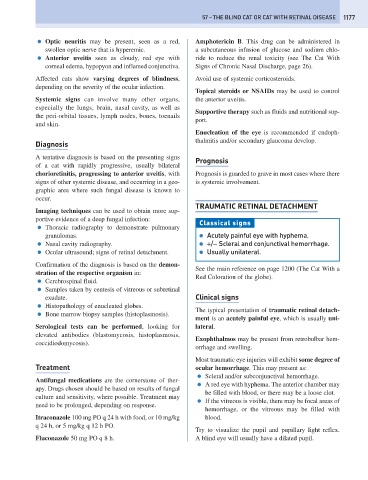Page 1185 - Problem-Based Feline Medicine
P. 1185
57 – THE BLIND CAT OR CAT WITH RETINAL DISEASE 1177
● Optic neuritis may be present, seen as a red, Amphotericin B. This drug can be administered in
swollen optic nerve that is hyperemic. a subcutaneous infusion of glucose and sodium chlo-
● Anterior uveitis seen as cloudy, red eye with ride to reduce the renal toxicity (see The Cat With
corneal edema, hypopyon and inflamed conjunctiva. Signs of Chronic Nasal Discharge, page 26).
Affected cats show varying degrees of blindness, Avoid use of systemic corticosteroids.
depending on the severity of the ocular infection.
Topical steroids or NSAIDs may be used to control
Systemic signs can involve many other organs, the anterior uveitis.
especially the lungs, brain, nasal cavity, as well as
Supportive therapy such as fluids and nutritional sup-
the peri-orbital tissues, lymph nodes, bones, toenails
port.
and skin.
Enucleation of the eye is recommended if endoph-
thalmitis and/or secondary glaucoma develop.
Diagnosis
A tentative diagnosis is based on the presenting signs
Prognosis
of a cat with rapidly progressive, usually bilateral
chorioretinitis, progressing to anterior uveitis, with Prognosis is guarded to grave in most cases where there
signs of other systemic disease, and occurring in a geo- is systemic involvement.
graphic area where such fungal disease is known to
occur.
TRAUMATIC RETINAL DETACHMENT
Imaging techniques can be used to obtain more sup-
portive evidence of a deep fungal infection:
Classical signs
● Thoracic radiography to demonstrate pulmonary
granulomas. ● Acutely painful eye with hyphema.
● Nasal cavity radiography. ● +/- Scleral and conjunctival hemorrhage.
● Ocular ultrasound; signs of retinal detachment. ● Usually unilateral.
Confirmation of the diagnosis is based on the demon-
See the main reference on page 1200 (The Cat With a
stration of the respective organism in:
Red Coloration of the globe).
● Cerebrospinal fluid.
● Samples taken by centesis of vitreous or subretinal
exudate. Clinical signs
● Histopathology of enucleated globes.
The typical presentation of traumatic retinal detach-
● Bone marrow biopsy samples (histoplasmosis).
ment is an acutely painful eye, which is usually uni-
Serological tests can be performed, looking for lateral.
elevated antibodies (blastomycosis, histoplasmosis,
Exophthalmos may be present from retrobulbar hem-
coccidiodomycosis).
orrhage and swelling.
Most traumatic eye injuries will exhibit some degree of
Treatment ocular hemorrhage. This may present as:
● Scleral and/or subconjunctival hemorrhage.
Antifungal medications are the cornerstone of ther-
● A red eye with hyphema. The anterior chamber may
apy. Drugs chosen should be based on results of fungal
be filled with blood, or there may be a loose clot.
culture and sensitivity, where possible. Treatment may
● If the vitreous is visible, there may be focal areas of
need to be prolonged, depending on response.
hemorrhage, or the vitreous may be filled with
Itraconazole 100 mg PO q 24 h with food, or 10 mg/kg blood.
q 24 h, or 5 mg/kg q 12 h PO.
Try to visualize the pupil and pupillary light reflex.
Fluconazole 50 mg PO q 8 h. A blind eye will usually have a dilated pupil.

